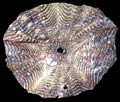Distinguished from Calveriosoma by having dactylous pedicellariae and obvious membranous gaps between interambulacral plates on the adapical surface. Differs from Hapalosoma by having admedial and ambulacral primary tubercles, although this may partially reflect the considerable size difference between the two type species. Mortensen (1935) separated Araeosoma from these two genera solely on the characteristics of their dactylous pedicellariae (absent in Calveriosoma, present in Araeosoma and Hapalosoma, the latter having the valves reduced to just their basal parts). However, Mortensen, himself (1935: 221) indicated that the three genera might better be considered as subgenera. In the absence of pedicellariae tests may be difficult to differentiate.
Differs from Asthenosoma in having large membranous gaps at the outer end of genital plates through which the gonopores open, and with sparser and smaller primary tubercles on the oral surface.
A cladistic analysis of extant species has been carried out by Mooi et al. (2004).
Mooi, R., Constable, H., Lockhart, S. & Pearse, J. 2004. Echinothurioid phylogeny and the phylogenetic significance of Kamptosoma (Echinoidea: Echinodermata). Deep Sea Research II 51, 1903-1919.
Mortensen, T. 1903. The Danish Ingolf-Expedition 1895-1896. Vol. 4, No. 2. Echinoidea, pt. 1, 198 pp., 21 pls. Bianco Luno, Copenhagen.
Mortensen, T. 1935. A monograph of the Echinoidea. Volume 2, Bothriocidaroida, Melonechinoida, Lepidocentroida and Stirodonta. C.A. Reitzel, Copenhagen.






